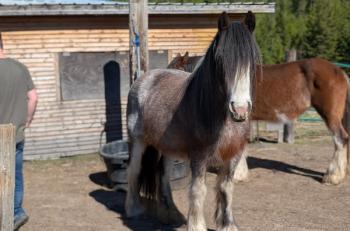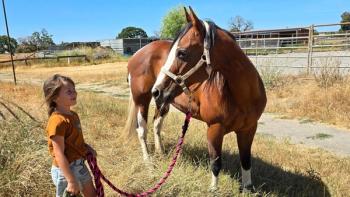
Challenges of endurance exercise: Hydration and electrolyte balance (Proceedings)
In human and equine athletes, loss of body fluid in sweat during prolonged exercise exceeds voluntary fluid replacement.
In human and equine athletes, loss of body fluid in sweat during prolonged exercise exceeds voluntary fluid replacement. This leads to a condition that has been termed involuntary dehydration. The magnitude of dehydration can be estimated by measuring body mass loss during the endurance event. This body mass loss usually persists for hours to days in the recovery period and water and electrolyte deficits are usually not fully replaced until one or more meals have been consumed following the exercise bout. Unfortunately, loss of body water and electrolytes can contribute to development of several medical or "metabolic" problems either during the exercise bout or even after successful completion of competition. Dehydration has long been considered the most important risk factor for development of medical problems in equine endurance athletes. However, recent evidence suggests that other factors, including a decrease in effective circulating volume and autonomic dysregulation leading to compromised tissue perfusion, may be equally if not more important factors.
Body fluid loss during endurance exercise
During endurance exercise performed by human athletes and horses, body fluids are lost primarily in the form of sweat. In contrast, dogs competing in endurance events lose fluids in the form of respiratory water loss and via urine (Figure 1). Sweating is essential for effective thermoregulation in both human athletes and horses but in both species sweating rates are generally excessive. That is, if all sweat produced was fully evaporated, the cooling effect would far exceed the metabolic heat load generated. However, not all sweat produced evaporates as large amounts can drip from the body and the evaporative cooling potential of this "wasted" sweat is lost. This loss of sweat is exacerbated when evaporation is compromised by ambient conditions of high humidity, due to the already high atmospheric water vapor pressure that limits the gradient between be the skin surface and the surrounding air.
Figure 1 Humans, dogs, and horses all compete in endurance exercise events during which deficits in body water and electrolyte content may develop. However, mechanisms of thermoregulation and maintenance of body fluids and effective circulating volume vary between these species. Humans and horses utilize evaporative cooling via sweating while dogs thermoregulate via respiration (panting). Human sweat becomes hypotonic with endurance training while horse sweat remains nearly isotonic due to species differences in sweat glands. In contrast, dogs primarily lose water via evaporative cooling across the respiratory tract. Thus, the magnitude of electrolyte depletion that may develop during prolonged endurance competition also varies with species.
In horses, sweating rates during endurance exercise are directly related to core body temperature and have been demonstrated to remain fairly steady during treadmill exercise, despite lack of fluid replacement. With varying endurance work intensity (and increases in core body temperature) under moderate ambient conditions, total sweat losses during treadmill exercise bouts of 45 km have ranged from 3-7% of body mass. Similarly, field studies of endurance rides have also shown body mass losses ranging from 3-7% by the end of 80- to160-km rides. During actual competition horses are offered water and feed to promote fluid and fuel replacement at multiple times during the rides and in field studies in which body mass loss has been measured at multiple times during the rides, a consistent finding has been that the majority of body mass loss occurs during the first half of the competition and that body mass remains fairly steady from that point forward. Because body fluid in sweat continues throughout exercise, maintenance of body mass during the later stages of the ride can only be explained by water and feed intake at a rate matching ongoing fluid losses. Again, the net loss of body fluid that is sustained by endurance athletes can be characterized as involuntary dehydration because it occurs in the face of readily available rehydration fluids.
Mechanism of involuntary dehydration
In both equine and human endurance athletes, insufficient thirst, due to concurrent loss of water and electrolytes in sweat, appears to be the most important mechanism causing involuntary dehydration. However, two species differences appear to make the magnitude of involuntary dehydration greater in equine endurance athletes. First, equine sweat remains isotonic during prolonged exercise while human sweat becomes hypotonic, in comparison to plasma tonicity. Thus, horses lose comparatively greater amounts of electrolytes in each liter of sweat produced. As a consequence, plasma osmolality rises more slowly in horses than human endurance athletes and because a rise in plasma tonicity is the most potent stimulus for thirst, a lesser osmotic thirst stimulus of thirst likely plays a greater role in horses than in human athletes. Second, transcellular fluid reserves in the lumen of the equine gastrointestinal tract are substantially greater (10-15% of body mass) in comparison to those in human athletes (1-2% of body mass). Thus, the equine athlete has a larger "fluid reserve" that can be called upon to replace sweat fluid losses during endurance exercise. As a consequence of these species differences, horses appear to be able to tolerate a relatively greater total loss of body fluid reserves during prolonged endurance competition.
Consequences of body fluid losses
Over the past several decades medical problems affecting both human and equine endurance athletes have been all too well publicized via lay publications and television broadcasts. For example, television coverage of major marathons has shown world-class athletes including Alberto Salazar staggering near the finish line while other athletes collapsed en route or shortly after finishing marathon and ultramarathon competitions. Of greater concern to veterinarians, horses have collapsed and even died during prestigious international endurance competitions as a consequence of the "exhausted horse syndrome."
Pathophysiology of medical problems that develop during and after endurance exercise
Exercise hyperthermia and dehydration: In endurance athletes, exercise hyperthermia leads to prolonged (typically excessive) sweating and loss of body fluids. As body fluid reserves become depleted, competition for adequate cardiac output to the skin and active skeletal muscle develops. As a consequence, thermoregulation via evaporative cooling at the skin surface can become limited by both a decrease in sweating rate and a decrease in skin blood flow. Subsequent uncontrolled hyperthermia was thus hypothesized to be the most important mechanism responsible for development of collapse and altered mentation during and after endurance competition. This mechanism gained initial support as a result of a 1969 publication authored by Wyndham and Strydom and entitled "The Danger of an Inadequate Water Intake During Marathon Running." The profound influence of this study came more from its misleading title than to its scientific content. However, the authors did not study nor did they identify any dangers resulting from an inadequate water intake during marathon running. In fact, the most dehydrated runners in their studies were also the most successful, as they won the competitions. Nevertheless, a positive outcome of the study was international rule changes to allow increased fluid intake during competitive races that up until that time had been largely less discouraged. A less desirable outcome was to induce a zeal among sports medicine practitioners to extol the dangers of dehydration during exercise and encouraged athletes to drink frequently during endurance exercise, despite absence of thirst. Further, it became commonly accepted that all athletes that collapsed in association with exercise had hyperthermia and dehydration that necessitated treatment with intravenous fluids.
During the same few decades, equine veterinarians officiating endurance rides also observed a number of clinical problems in horses that were collectively described as the "exhausted horses syndrome." Affected horses showed signs including synchronous diaphragmatic flutter, muscle fasciculations, colic signs attributed to ileus, rhabdomyolysis, collapse, and multiple organ failure leading to death. Similar to physicians caring for exhausted human athletes, veterinarians assumed that these medical problems were a consequence of dehydration due to prolonged sweating during the exercise bout. However, unless ambient conditions were challenging (high heat and humidity), actual hyperthermia was rarely documented but treatment included fluid replacement in the form of water and electrolytes administered via a nasogastric tube or intravenous catheter.
Exercise-associated hyponatremia: For human athletes, the recommendation of liberal drinking during endurance exercise was strongly promulgated during the last couple of decades of the 20th century (Figure 2). In combination with a dramatic increase in marathon running towards the end of that century, this recommendation actually led to development of a new problem among human endurance athletes: exercise-associated hyponatremia. Hyponatremia, induced by excessive fluid replacement with water or a variety of hypotonic sports drinks, actually resulted in serious neurological impairment and death in a number of "weekend warrior" marathon competitors.
Figure 2 Over the past few decades human athletes have been encouraged to drink frequently during endurance competitions, despite a lack of thirst, leading to an increase in development of life-threatening hyponatremia in slower marathon participants.
Fortunately, despite aggressive management of endurance horses to encourage fluid intake, primarily by frequent administration of electrolytes before and during competition, riders have never been able to get their horses to drink excessive amounts of rehydration fluids (Figure 3). Thus, hyponatremia has not yet been recognized as a serious problem of endurance horses.
Figure 3 In contrast to their human counterparts, horses can absorb substantial amounts of water and electrolytes from the large colon during prolonged exercise, leading to a typical "tucked-up" appearance to the abdomen toward the later stages of competition. Further, oral electrolyte pastes are commonly used to stimulate drinking in endurance horses.
Decrease in effective circulating volume and post-exercise hypotension: As liberal use of intravenous fluids became the norm for treatment of collapsed marathon runners and exhausted endurance horses, a common clinical observation was that athletes of both species often recovered rapidly in response to administration of a volume of fluids that was substantially less than that required for correction of estimated fluid losses. This observation led to the suggestion that decreases in effective circulating volume, rather than the overall magnitude of body fluid loss, may be a more important pathophysiologic mechanism for either collapse or exhaustion in human and equine endurance athletes. In fact, in 1995 Noakes and coworkers in South Africa called into question the importance of the overall loss of body fluids during endurance exercise and encouraged researchers and sport medicine physicians to focus greater attention on dysregulation of autonomic vascular tone leading to systemic hypotension as a potentially more important factor in development of collapse, especially in the immediate post-exercise period. Rather than administration of intravenous fluids as emergency treatment of collapsed athletes (that have a normal core body temperature), this group advocated resting in the supine position with the lower extremities elevated for several minutes. In many subsequent events, this recommendation has had good success in initial triage of collapsed endurance athletes, furthering support for hypotension as an important mechanism leading to collapse. Dysregulation of autonomic tone leading to hypotension has been hypothesized to lead to pooling of blood in the lower extremities on cessation of prolonged endurance exercise. As a consequence, development of orthostatic hypotension near the finish, and especially following completion of the exercise bout, may be a more important cause of collapse than the magnitude of body fluid loss.
In an attempt to investigate whether or not post-exercise hypotension develops in endurance horses, the author and colleagues recently measured indirect blood pressure in horses that successfully competed 80- to 160-km endurance rides. Surprisingly, we also found a substantial reduction in blood pressure during the early recovery period following ride completion in some but not all horses studied (unpublished observations). Because horses would seem to have a comparatively small capacity to pool blood in their lower limbs, we speculate that this transient period of hypotension might more likely be explained by rapid restoration of blood flow to splanchnic tissues that receive limited cardiac output during exercise.
Conclusion
All in all, human and equine endurance athletes have both similarities and differences with regard to hydration status during and after endurance exercise. Although not emphasized in this discussion, both human and equine endurance athletes that compete under conditions of high ambient temperature and humidity are clearly at increased risk of developing exercise hyperthermia and associated medical problems. When a markedly elevated core body temperature is detected in these athletes, aggressive cooling and support with intravenous fluids remains the accepted approach to emergency treatment. However, it may be likely that both decreased effective circulating volume and dysregulation of autonomic vascular tone, contributing to hypotension, may be more important mechanisms, rather than total body fluid loss, in the majority of athletes suffering from collapse or "metabolic" problems during and following endurance exercise.
Supplemental readings available on request to the author
Newsletter
From exam room tips to practice management insights, get trusted veterinary news delivered straight to your inbox—subscribe to dvm360.






